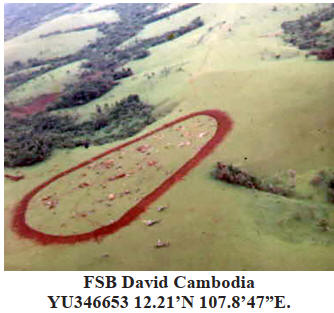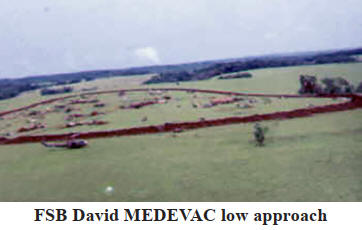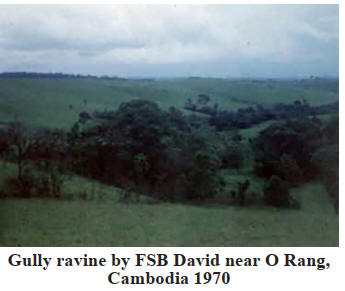Saber Article Index
2019 Nov-Dec
Mike Bodnar 307B N Main Copperas Cove, TX 76522 254-542-1961 E-mail:
mbodnar27@gmail.com
 I received an email from Joel Chase who
said he was a platoon leader in D Co 1-5 Cav. On 14 Jun 70 he was on
perimeter guard at FSB David in Cambodia. The NVA sent a reinforced
company to attack David and left behind twenty-six dead with no U.S. KIA.
Joel said he was the worst of the U.S. WIA. You can read about the attack
on their website: <https:// echorecon.com/sunday-june-14th-1970/>.
I received an email from Joel Chase who
said he was a platoon leader in D Co 1-5 Cav. On 14 Jun 70 he was on
perimeter guard at FSB David in Cambodia. The NVA sent a reinforced
company to attack David and left behind twenty-six dead with no U.S. KIA.
Joel said he was the worst of the U.S. WIA. You can read about the attack
on their website: <https:// echorecon.com/sunday-june-14th-1970/>.
The
1-5 Cav Battalion Surgeon then, Jon G. Walker, says: “On June 14,
1970, I, Jon G Walker, was CPT, Medical Corps, U.S. Army and I was the
Battalion Surgeon of the 1-5 Battalion of the 1st Cavalry Division. At
FSB David my Aid Station was located near the woods on the southeast
perimeter and consisted of a partially below grade hole dug by
backhoes. My medics and I gained enough vertical height to stand by
creating pillars of sandbags on the edges of the hole and laying logs
across the pillars. We then laid PSP strips on top of the logs, covered
them with plastic and more sandbags. The hole was maybe ten by twelve feet.
My head medic, an E5 named Rick Fortune, and I had cots in the Aid Station.
A couple of other medics had built a ‘hootch’ out of corrugated culvert
raised up on sandbags which abutted one corner of the Aid Station. “I
had just gotten orders for my R&R and planned to hitch a ride to the rear
area on June 13th to call my wife to make reservations for Hawaii. I
never got off FSB David because the weather on June 13, 1970 was so bad
that no one was flying.
“For some reason neither Rick nor I were sleeping
well that night. Around 2:30 am we heard an explosion followed by M16 fire
coming from what seemed like the northeast perimeter of the base. We were
immediately up, and it seemed then that all hell broke loose. Some of my
medics came down to the Aid Station. I was standing near the opening
where the hootch abutted the Aid Station when there was an explosion
right outside that knocked me across the Aid Station and onto the floor.
We assumed it was a grenade and that another one would soon be lobbed
into our hole. That didn’t happen so I eventually stood up and shined my
flashlight into the hootch fully expecting to be shot. What I discovered was
that an RPG had landed at the other end of the hootch and the hootch
directed the concussion into the Aid Station where I was standing. Around
that same time, we began hearing calls for ‘Medic!’ “I was ready to go
out when cool-headed Rick Fortune told me to stay put. I was the only
doctor on the base and he and the other medics needed to know where I
would be.
 “Shortly thereafter I started receiving the wounded. It was
chaos, the ground was muddy, and it was still raining. We were next to
a mortar pit so as they unwrapped the plastic from their ammo, they
would throw it over to us for use as covers.
“Shortly thereafter I started receiving the wounded. It was
chaos, the ground was muddy, and it was still raining. We were next to
a mortar pit so as they unwrapped the plastic from their ammo, they
would throw it over to us for use as covers.
“I quickly assessed each
Soldier and tried to determine the extent of the injuries and what could
be done. My supplies were meager…Kling wrap, Ace bandages, gauze,
Vaseline gauze, sterile saline and syrettes of morphine (imagine a small
tube of toothpaste with a needle attached. You put the needle in the patient
then squeeze the morphine out of the tube).
“Certain injuries remain
in my memory: a SGT who was shot in the thigh with an AK-47, the entry
wound was small but the exit wound in the back of his leg was huge. I
packed it with gauze and wrapped it tightly with an ace wrap which seemed
to control the bleeding; a Soldier with a pneumothorax (collapsed lung)
and all I had to plug the wounds was Vaseline gauze (maybe LT Chase?); a
Soldier with multiple shrapnel wounds on his chest and face who was awake
and looked at me when I spoke but didn’t respond; a Soldier who didn’t
look too bad initially but had a massive scalp wound on the back of his
head. I cleaned it with saline then replaced the skin flap and wrapped his
head with Kling holding the flap in place. There were numerous broken
bones and lacerations. We splinted what we could and dressed the wounds
but didn’t have the time or the supplies to suture.
“All told we had
thirty-three wounded Soldiers for about three to four hours. We had no
air support because of the weather and no way to evacuate anyone. When
the weather cleared a little around 6 am the first chopper in was a Huey
MEDEVAC chopper. I tried to evacuate the most serious on it and was able to
get nine men (as I recall) out. Shortly thereafter I got word that a Chinook
had just delivered artillery ammo to the other side of the base and was
coming over to evacuate the wounded. They settled down just outside the
perimeter and I was able to get everyone else on board. So, within five
minutes we went from thirty-three wounded to none.
“As I gradually
came back to reality, I didn’t fully comprehend what had just happened. I
was relieved but other emotions just swirled. I still remember blood just
running in rivulets across the ground. I eventually went for a walk with
Rick Fortune and viewed at least twenty-eight enemy bodies outside the
perimeter, many of them just blown apart. We thought we heard an AK-47
near the Aid Station at one point and, indeed, found spent AK shells on
the ground. I assume that the shooter was on the roof of the Aid Station.
Was he the one who was shot?
 “I later found out that Rick Fortune went
out without his ‘steel pot’ to identify him as American. The sergeant
major (whose name I can’t recall but would like to know) told me that he
had Rick in his sights but recognized him at the last minute and didn’t
shoot.
“I later found out that Rick Fortune went
out without his ‘steel pot’ to identify him as American. The sergeant
major (whose name I can’t recall but would like to know) told me that he
had Rick in his sights but recognized him at the last minute and didn’t
shoot.
“We didn’t lose any GIs at the base and I subsequently learned
that all survived I’m especially pleased to know that. I eventually got a
Bronze Star with a V, which was certainly, a novelty at my next
assignment in the Out-Patient Clinic at Fort Gordon, GA.
“And, that’s
my story. I haven’t been able to find my name anywhere in the records but
occasionally look. Again, I was the only doctor on FSB David on that
infamous day. I left the Army in the fall of 1971, specialized in Urology
and am now retired after practicing in Lancaster, PA, for over thirty years.
Jon G. Walker, MD.
”Mike Crutcher, E 1-5 Cav CO, responded that the
sergeant major then was CSM Bell. The doctor followed up with: “CSM
Bell…that’s right. I really liked and related to him. As an MD in an
infantry outfit I always felt out of place. He would go out of his place
to talk to me!”
Joel Chase apparently, indeed, was the Soldier with the
collapsed lung. He says, “The first shot fired on David on 14 June came
from an M16. A trip went off and a guard on a bunker in my sector took a
shot when he thought he saw movement in our wire. There was no return fire,
but I was convinced we were in for trouble. A thirty-minute visual search
produced no results, and everyone wanted to pack it up. Mortar and trip
flares thrown simply created eerie glows in the fog. Then, a guy standing
next to me said; ‘2-6 what is that?’ and pointed about thirty feet out. I
was sighting down his arm when a burst of AK-47 fire erupted. The sapper
was inside our wire and he decided to drill me a new ‘innie’, but the
rounds skimmed off the berm and grazed the top of my head.
“Then all hell
broke loose with red and green tracers piercing the darkness. I jumped on
the horn to the mortar guys and requested they begin their preplanned fires in the ravine and walk them up the ridge. Then I called Bill Vowell and
gave him a sit-rep when a chi-com frag rolled up next to me with the fuse
sparkling. It went off right in my face with a flash of light and pop. The
pain was tremendous.
“I tried to get up and run but couldn’t see nor
hear. My legs had multiple shrapnel wounds and collapsed, so I attempted
to crawl, but my right elbow was pulverized and simply flapped around, so
I slithered like a snake until I found some sandbags for a little cover.
It was of little use as I got hit several more times by either B-40 or
mortar shrapnel.
 “While I didn’t know it at the time, I took three pieces
of shrapnel to my heart (two of which are still there) and one piece got
pumped into the brachial artery of my arm. Additionally, my right lung
was punctured, my liver was lacerated, kidney cut up, and my eyes were
perforated. But I made it somehow and have led a relatively normal life
with just one eye. The Army decided they didn’t require my services any
longer and retired me at one hundred percent disability.
“While I didn’t know it at the time, I took three pieces
of shrapnel to my heart (two of which are still there) and one piece got
pumped into the brachial artery of my arm. Additionally, my right lung
was punctured, my liver was lacerated, kidney cut up, and my eyes were
perforated. But I made it somehow and have led a relatively normal life
with just one eye. The Army decided they didn’t require my services any
longer and retired me at one hundred percent disability.
“So, there you
have the true story of how the battle for FSB David started. Those who
fought did so heroically and professionally.” It’s important to note that
during that attack the defenders had no external artillery nor air support,
because of their location and weather conditions. J.D. Coleman in his
book Incursion says that the 1st Cav 1st Brigade had turned over its AO
in Tay Ninh to the 25th ID and moved with two battalions into the O
Rang area, which was due north of the II Corps-III Corps boundary. “In
mid-June the 5th VC Division sent a couple of its 174th Regiment on a
mission of death directed against FSB David, the command post for Bob
Kingston and his 1st Brigade headquarters. For two hours the NVA had a
go at David, but found that a 1st Cav firebase, even in Cambodia, was
too tough a nut to crack. The NVA lost twenty-eight men; the cost to the
Americans was twelve wounded.
”It sounds to me that Joel Chase, being the
worst of the wounded, should have gone out on the MEDEVAC that got in at
6 am. That’s what MEDEVAC was for, to take out the most urgent first. But
I wasn’t there and don’t know what exactly transpired. Fortunately, all
the wounded survived.
Rethinking what I’ve read, Joel could have gone out
on the MEDEVAC. But, he writes, “When the hook delivered much needed
mortar ammo, I was loaded on board for a ride to FSB Buttons. I was
totally out of it but have learned that the hook landed on the Huey pad
and blew their tents all to hell. Nobody seems to know who the hook
crew was because they probably came from Quan Loi.” If he was totally
out of it, as he says, he may not have remembered if he was on a Huey
or Chinook.
My MEDEVAC crew went up to FSB David every day when it was
first built and parked it until we were called. I’ve included photos that
I took with my Instamatic of FSB David from the air and on the ground
beyond the berm. You can see the lushness of the area and the ravines
the NVA used to infiltrate. Color versions are better and can be viewed
on my webpage: <http:// mbodnar27.tripod.com/15.html>.
I remember on
one occasion, probably tired of just sitting there, we took off and burned
some fuel on call in the air. I think I remember the pilot was Ray Zepp.
Mr. Zepp was monitoring the radio and had it on the intercom. We picked up
on a grunt unit getting into a firefight. The screaming and yelling was
gruesome. I think that was B 5-7 Cav at Shakey’s Hill, which was 23 May
70. I don’t recall going in when they needed a MEDEVAC, but we would have
if called, as any
other MEDEVAC would when the time came. Unfortunately, I don’t remember
many of our pickups. There were dozens of them, they say you only seem to
remember what was most traumatic.
Joel Chase wrote, “Several years ago a
member of that 15th MED Bn Assn contacted me and invited me to their
reunion. I said no but after some thought I decided to attend to show
those incredible people that some of us survived. While I have not been
able to discover the pilots or crew who evaced me, perhaps nobody wants
to accept the blame for doing so. After attending two reunions of the
15th MED Bn Assn, let me say that it was a humbling experience just being
in the same room with those true heroes. They are the real deal. Thank you
15th MED Bn”
I wasn’t able, yet, to find out who knew about Joel, and
who invited him to the 15 MED Assn Reunion. As he stated, he doesn’t know
who MEDEVACed him, but according to him, he went out on the hook. It
would still be nice to know what MEDEVAC crew did get into FSB David at 6
am on 14 Jun 70.
Always remembering our 1st Cav Troops on duty around the
world; over and out.
FIRST TEAM! Garryowen
Mike
Bodnar 2\7 '69 MEDEVAC 1-7\70
SO THAT OTHERS MAY LIVE